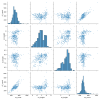TITLE: 04/29 Day Shift: 1430-2330 UTC (0730-1630 PST), all times posted in UTC
STATE of H1: Planned Engineering
INCOMING OPERATOR: None
SHIFT SUMMARY: We had a few earthquakes roll through in the morning, 6.8 from south of New Zealand and a 4.8 from Puerto Rico. The LVEA is now in LAZER HAZARD.
LOG:
| Start Time | System | Name | Location | Lazer_Haz | Task | Time End |
|---|---|---|---|---|---|---|
| 14:20 | FAC | Kim & Nellie | LVEA | N | Tech clean, in at 14:20 | 15:25 |
| 15:35 | ISC | Betsy, Camilla | LVEA | N | Parts/tools search | 15:46 |
| 15:48 | FAC | Kim & Nellie | EndY, then X | N | Tech clean | 17:28 |
| 15:50 | SUS | Rahul, Betsy | LVEA | N | RM2 work | 16:27 |
| 15:54 | FAC | Eric | LVEA | N | Help with clean room move, BSC8 | 17:22 |
| 15:55 | IAS | Jason | LVEA | N | Retreive FARO | 15:58 |
| 15:55 | VAC | Jordan | LVEA | N | Purge air checks | 16:04 |
| 15:56 | FAC | Tyler | LVEA | N | Cleanroom move (BSC8), scissor lifts, Craning | 17:49 |
| 16:10 | VAC | Gerardo | LVEA | N | Join HAM1 crew | 16:27 |
| 16:51 | EE | Fil, Ken | LVEA | N -> Y | HAM4/5 cable tray work | 21:36 |
| 17:11 | PEM | Sabby | Arms, site | N | Collect flags around site | 20:02 |
| 17:12 | VAC | Gerardo | LVEA | N | Take septum cover off | 18:02 |
| 17:13 | ISC | Camilla | LVEA | N | Help with septum covers | 18:33 |
| 17:16 | EE | Marc | LVEA | N | Check Chassis, check upgrades | 17:36 |
| 17:20 | VAC | Jordan | MidX | N | LN2 pump | 17:47 |
| 17:36 | EE | Marc | EX, EY, MY | n | Looking for parts + grabbing serial numbers | 18:51 |
| 17:37 | FAC | Eric | Fire pump room | n | Running fire pumps | 18:05 |
| 17:46 | SUS | Rahul | LVEA | N | HAM1 work, move curtains | 18:22 |
| 17:47 | Mike | LVEA | N | Check out/in with HAM1 | 18:35 | |
| 17:54 | FAC | Christina | Receiving | N | Moving stuff and trash | 19:39 |
| 17:55 | ISC | TJ | LVEA | N | Look for tubing | 18:41 |
| 18:00 | FAC | Kim & Nellie | LVEA | N | Tech clean, Kim out at 18:42 | 19:10 |
| 18:18 | ISC | Betsy & RyanS | LVEA | n | Inpect CR and boxes | 18:33 |
| 18:27 | ISC | Ibrahim | LVEA | N | Join Betsy and RyanS | 18:33 |
| 18:49 | FIT | Ibrahim | Yarm | N | Brisk walk | 19:52 |
| 19:31 | EE | Ken | LVEA | N -> Y | Roll up high bay door | 20:36 |
| 19:20 | CAL | Tony | PCAL lab | N | PCAL work, in at 19:20 | 19:40 |
| 19:49 | OPS | TJ | LVEA | N -> Y | Hazard transition | 19:56 |
| 19:58 | ISC | Keita | LVEA | Y | IOTL2 work | 20:44 |
| 19:59 | ISC | Camilla | LVEA | Y | Join Keita | 20:37 |
| 20:02 | FAC | Tyler | LVEA | Y | Bring bangbox from lVEA to staging | 20:11 |
| 20:02 | ISC | Sheila | LVEA | Y | Join IOTL2 crew | 20:36 |
| 18:15 | FAC | Randy, Jim, Mitch | EndY | N | Wind fence | 21:24 |
| 20:43 | CAL | Tony, Francisco | EndY | Y | End station measurement | 22:49 |
| 21:52 | ISC | Elenna, Sheila, Camilla | LVEA | Y | HAM1 ISC work | 23:45 |
| 21:59 | VAC | Jordan | LVEA | Y | Grab parts | 22:11 |
| 22:08 | VAC | Gerardo | LVEA | Y | See whats needed to decomis HAM2 oplev | 22:16 |
| 22:24 | SEI | Jim | LVEA | Y | Look for parts and such, klapton | 22:37 |
| 22:38 | SEI | Jim | Ends, Mids | N | Parts search | Ongoing |
| 22:49 | CAL | Tony | PCAL lab | LOCAL | FInish end station measurement | Ongoing |
| 22:53 | CAL | Rick, Dripta | PCAL lab | LOCAL | Checks | Ongoing |
| 22:53 | SAF | Richard | LVEA | Y | Safety checks | 23:00 |
Some of the work today includes:
- EY wind fence work Ongoing
- HAM1 cable work ?
- Ground checks of LSC/ASC diode boxes now fully cabled Done alog84174
- HAM1 - RM finish SUS troubleshooting - get suspended with good TFs Ongoing alog84178
- VAC - HAM1 septum plate removal Done alog84175
- PCAL EndY DONE
- HAM4/5 cable trays with craning Done?
- When all SUS, SEI, PSL seem in good order, transition to Laser Haz and perform 200mW lockout power into HAMs Ongoing
- Model work, DAQ restart No Restart alog84177
- Clean room moves, BSC8 DONE
- IOT2L realignment alog84187













































